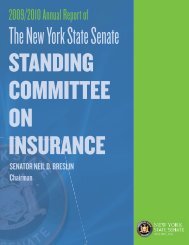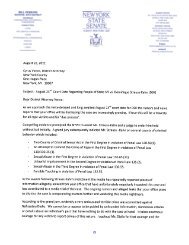Crime Committee Report e.indd - New York State Senate
Crime Committee Report e.indd - New York State Senate
Crime Committee Report e.indd - New York State Senate
Create successful ePaper yourself
Turn your PDF publications into a flip-book with our unique Google optimized e-Paper software.
XXI.<br />
Conclusion<br />
We have made great advances this past legislative session. In no small feat, we have turned<br />
away from decades of overreliance on a punitive drug enforcement strategy, marred by racial<br />
bias. Based upon the rate of recidivism, incarceration as a mechanism to deter unlawful activity<br />
has largely proven to be counterproductive. The constant removal and return of prisoners<br />
compromises the economic stability of our neighborhoods, thereby leading to the further<br />
destabilization of communities. According to a study on the “spatial effects” of high incarceration<br />
rates by Jeffrey Fagan, “[i]ncarceration begets more incarceration, and incarceration also<br />
begets more crime, which in turn invites more aggressive enforcement, which then re-supplies<br />
incarceration.” 41<br />
It is beyond dispute that the imposition of harsh criminal penalties is the wrong paradigm<br />
for addressing the problems related to chemical dependency, thus the necessity for reform of<br />
our drug laws. A new and more effective model based on a public health frameworks is a better<br />
course of action that has broad support among <strong>New</strong> <strong>York</strong>ers. 42<br />
To the extent that public policies, independent of other factors, can successfully effect and<br />
sustain reductions in crime, victimization and incarceration, both punishment and prevention<br />
— prisons and programs — are both necessary. As is the case in passing sex offender laws<br />
and residency restrictions, policymakers are doing their best to protect society — particularly<br />
its most vulnerable members, children. Yet many of these laws have been enacted without the<br />
benefit of evidence about which approaches work best. To get the best public safety outcomes,<br />
we must devote resources to stopping the most serious and repeat offenders from harming<br />
people and also work to rehabilitate those who are charged with less serious offenses and who<br />
objectively present less or no risk to re-offend.<br />
Moreover, a fiscal crisis requires strict cost-cutting and creative ideas, all the more reason to<br />
implement policies that effect real reform and are not rooted in the status quo. Henceforth,<br />
<strong>New</strong> <strong>York</strong>ers can expect its legislative leader to address budgetary woes while performing a<br />
pivotal role in pointing criminal justice practices in a more constructive direction. Real reform<br />
means giving the judicial system the discretion and resources to view chemical dependency as a<br />
health problem and making efforts to address the cause of addiction and the criminal conduct<br />
that often follows such abuse.<br />
To that end, we have redirected funds to provide individual and group counseling for persons<br />
with chemical dependency, and provided judges a flexible and broad range of programs<br />
that include outpatient and residential treatment programs. For those who require tougher<br />
sanctions, we have given judges the authority to place offenders in Shock Incarceration Correctional<br />
Facilities and the Willard Program. Both of these programs incorporate a “boot camp”<br />
curriculum, as well as intensive counseling. If treatment fails or if the defendant re-commits<br />
a crime while attending treatment programs, we made sure that stiff sentencing guidelines<br />
remained available to judges as a viable option.<br />
Since attaining majority status, the <strong>Senate</strong> Majority Conference has taken a progressive approach<br />
to curbing criminal misconduct. Mental illness, chemical dependency, poverty, homelessness<br />
and hopelessness are all contributory factors to criminal behavior. The need to rightsize<br />
our prison system is abundantly apparent, and as our policies continue to have a positive<br />
impact, we anticipate further prison closings in years to come. Mainly due to our drug law<br />
reform policies and imposition of stiff sentences for violent felony offenders, the crime rate<br />
and the prison population continues to decline. Yet, when we close a prison, there is a “ripple<br />
effect” that tears through the heart, economy and tax base of the local communities. The Sen-<br />
41 Jeffrey Fagan, Valerie West, Jan Holland, Reciprocal Effects of <strong>Crime</strong> and Incarceration in <strong>New</strong> <strong>York</strong> City Neighborhoods,” 30 Fordham Urb. L.J.<br />
1551, July 2002, at p. 1554.<br />
42 Legal Action Center survey, June 2002.<br />
Standing <strong>Committee</strong> on <strong>Crime</strong> Victims, <strong>Crime</strong> and Correction | 2009-2010 <strong>Report</strong> 73


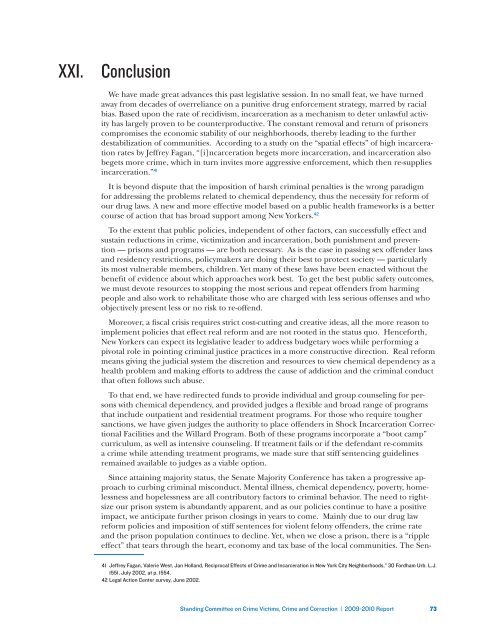
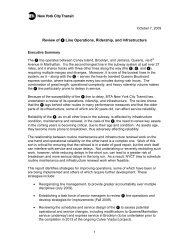



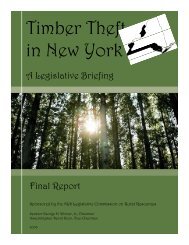

![[PDF] Proposed MTA Capital Program - New York State Senate](https://img.yumpu.com/24854139/1/190x245/pdf-proposed-mta-capital-program-new-york-state-senate.jpg?quality=85)



